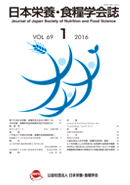All issues

Predecessor
Volume 69, Issue 1
Displaying 1-3 of 3 articles from this issue
- |<
- <
- 1
- >
- >|
Review
-
(Young Investigator Award of JSFNS (2015) )Wataru Mizunoya2016Volume 69Issue 1 Pages 3-9
Published: 2016
Released on J-STAGE: February 29, 2016
JOURNAL FREE ACCESSThere are two major muscle fiber types: type 1 fibers (slow-twitch oxidative) and type 2 fibers (fast-twitch glycolytic) . Muscle fiber type is a critical physiological property that affects sports performance as well as metabolic ability. First, we developed an electrophoresis protocol that allows clear separation of the myosin heavy chain (MyHC) isoforms, which are common molecular markers of muscle fiber type. Then we examined the effects of nutritional treatment on muscle fiber type in rats. Food deprivation for 48 h did not alter the MyHC composition of skeletal muscles. Exposure to cold (4℃) for 4 weeks increased slow-type MyHC1 in the soleus muscle. Intake of fish oil for 4 weeks induced significantly lower levels of fast-type MyHC2B and higher levels of the intermediate-type MyHC2X composition in the extensor digitorum longus (EDL) muscle in comparison with soybean oil intake. These results clearly indicate that muscle fiber type can be modified by nutritional components.View full abstractDownload PDF (1070K)
Original Papers
-
Shiori Sugawara, Takemi Akahane, Kennichi Fukui, Ikuyo Tsukamoto2016Volume 69Issue 1 Pages 11-19
Published: 2016
Released on J-STAGE: February 29, 2016
JOURNAL FREE ACCESSThe relationship between insulin resistance (IR) and n-3 polyunsaturated fatty acids (n-3 PUFA) has not been fully elucidated. In this study, the association of an indicator of IR, HOMA-IR, with food intake or the fatty acid composition of plasma phospholipid (PL) was investigated in 377 healthy Japanese men and women who participated in a health examination. The values of HOMA-IR were inversely associated with the levels of eicosapentaenoic acid (EPA) , docosahexaenoic acid (DHA) , and n-3 PUFA in plasma PL (Ptrend= 0.024, 0.013, and 0.031, respectively) . Logistic analysis showed that the odds ratios (95%CI, Ptrend) of high HOMA-IR (HOMA-IR≧2.5) adjusted by sex, age, BMI, physical activity, smoking, and alcohol intake for the fourth (highest) compared with the first quartile of DHA, EPA+DHA, n-3PUFA, and dihomo-γ-linolenic acid in plasma PL were 0.40 (0.18-0.91, p trend=0.015) , 0.37 (0.16-0.83, p trend=0.021) , 0.42 (0.19-0.92, p trend=0.021) , and 2.61 (1.07-6.41, p trend=0.030) , respectively. These results suggest that low levels of DHA, EPA+DHA, and n-3PUFA and a high level of dihomo-γ-linolenic acid in plasma PL are associated with IR.View full abstractDownload PDF (707K) -
Ayu Matsunaga, Kumiko Kizu, Mao Arita, Junko Hirose, Hiroshi Narita2016Volume 69Issue 1 Pages 21-28
Published: 2016
Released on J-STAGE: February 29, 2016
JOURNAL FREE ACCESSFemale BALB/c mice were fed cow’s milk proteins. After sensitization with ovalbumin and alum, they were bred and fed egg white proteins during lactation. The pups breastfed by them were named Allergy-Egg (AE) group. As controls, Egg (E) group was breastfed by non-sensitized mothers fed egg white proteins during lactation, and Milk (M) group was breastfed by non-sensitized mothers fed milk proteins throughout the experiment. After sensitizing all the pups with ovalbumin and alum, diarrhea associated with experimental Th2 intestinal inflammation was tested by oral administration of ovalbumin. Diarrhea was suppressed in AE and E pups in comparison with M pups. Concomitantly, AE and E pups showed a low level of serum anti-ovalbumin IgE and suppression of ovalbumin-dependent IL-4 synthesis by spleen cells. Immune complexes of ovalbumin IgA and IgG1 were significantly increased in AE breast milk. Thus it was proved that oral tolerance was induced in the pups via breastfeeding even from allergic mothers as well as from non-allergic mothers. Immune complexes in breast milk are suggested to be involved in this process.View full abstractDownload PDF (916K)
- |<
- <
- 1
- >
- >|